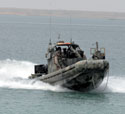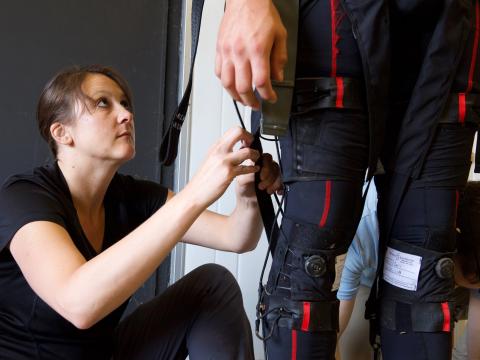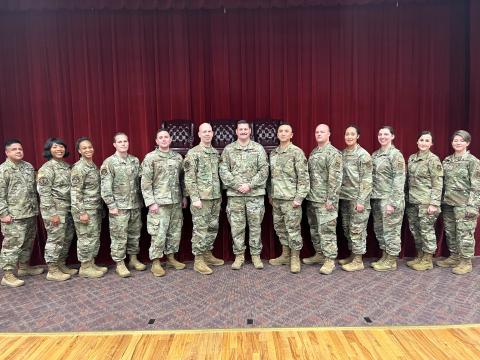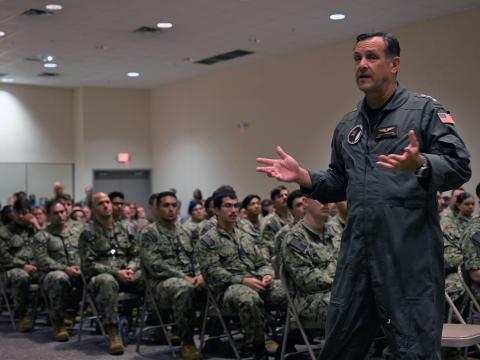Riverine Challenges Mirror Joint Operations
The new maritime mission taxes command and control along with interoperability. 
Members of the U.S. Navy’s Riverine Squadron 1 (RIVRON 1) patrol Iraq’s Lake Qadisiya in a small unit riverine craft. The Navy’s first riverine squadron since the Vietnam War, RIVRON 1 is supporting U.S. Marine Corps operations in Al Anbar province. The Navy is forming two more riverine squadrons as it extends its force through inland waterways.
Tasked with a smorgasbord of new missions, the U.S. Navy is building a riverine force with operational capabilities ranging from brown water combat to humanitarian assistance and disaster relief. This group already has tasted combat in
As the Navy faces a host of responsibilities involving maritime security, littoral operations and inland warfighting support, it is striving to extend its reach along its traditional operating medium—water. This entails providing vital command and control (C2) links under less-than-ideal conditions, applying fleetwide skills in nontraditional areas and incorporating new technologies that ensure interoperability with the rest of the Navy as well as in joint and coalition operations.
The new riverine force has been established by the Navy Expeditionary Combat Command, or NECC, and operates under its authority. Riverine, with about 800 personnel, is just one of the many capabilities within this new 37,000-person command, which was stood up about one and a half years ago. This standup tasked the NECC with supporting the U.S. Marine Corps’ mission in
The command is building three riverine squadrons. One of them, Riverine Squadron 1 (RIVRON 1), currently is conducting operations in western
Rear Adm. Donald K. Bullard, USN, commander of the NECC, explains the new command’s and riverine force’s origins. “The Navy recognized that there are maritime expeditionary capabilities that we already had inherently within the Navy as well as core competencies that we need to revitalize given the landscape of the threat and this war on terrorism,” he shares. “So we were stood up to better organize those capabilities, to ensure that we had the ‘man, train and equip’ of those capabilities right and—given that littoral and brown water environment—to be able to provide mission-specific adaptive force packages that had a connectivity of command and control to hook into the joint force maritime commander or the joint task force commander.”
One key riverine capability will be the ability to support other countries that lack traditional navies. The U.S. Navy’s riverine force will help them increase their means for operations against adversaries in coastal and inland waterways. Denying terrorists, smugglers and other malefactors freedom of movement in those arenas will improve those nations’ maritime security, Adm. Bullard states.
“Riverine is not about just combat operations. It also is about engagement with other countries to build their capability to contribute to maritime security,” he declares.
Adm. Bullard relates that many overseas areas lack established lines of communications on land and along inland waterways. These inland waterways can be used for sanctuaries and communications links for a variety of adversarial groups and activities. Riverine capabilities allow the Navy to extend its activities from blue water and green water into brown water, he offers, noting that “now, we have a full continuum of capability to do maritime security operations whether out in the oceans, in the straits or all the way into the inland waterways.”
This continuum includes C2, he emphasizes. It allows the Navy to extend maritime domain awareness to provide operational continuity as well. “When you take riverine connected to Navy coastal warfare connected to LCS [littoral combat ship] connected to ESGs [expeditionary strike groups] and battlegroups, you can see how we have that continuum of capability,” he observes.
Integrating riverine into the Navy’s C2 continuum is an ongoing effort. “We’re still in the process of developing that because our focus was to integrate [riverine] into the Marine Corps’ command and control for the current mission,” Adm. Bullard explains. That integration has been accomplished fully. To integrate riverine into the Navy’s C2, the NECC has a concept of operations and is developing training exercises. But overall, this effort is still under development.
Technology also poses challenges. The Navy employs a variety of sensors deployed on different platforms, and delivering their information to a riverine force is more difficult than delivering it to a blue water ship or to a shore facility. While this task is doable, it also is under development, the admiral says.
“Providing the proper C4I [command, control, communications, computers and intelligence] from small boats is different than doing it on a cruiser or a carrier,” the admiral states. “We’re looking at different technical challenges and how we basically integrate C4I into small-boat operations in rivers—it’s a different environment than the open ocean or even littoral [waters].” Small riverine craft lack the capacity and power sources of larger vessels, and they face operating conditions that can include canals and waterways with overhanging foliage canopies.
Capt. Dave Balk, USN, assistant chief of staff for strategy and new technology (N-9) at the NECC, shares that the command has tapped many sources for necessary technologies. New lightweight armor has allowed riverine forces to travel in boats with much greater protection than before, for example. Almost as important are new communications technologies. These have allowed boats upriver to maintain solid communications with the ashore C2 element.
The captain explains that most riverine communications largely rely on high frequency (HF) radio links. The riverine squadrons have a scalable communications suite that ranges from citizens’ band radio to satellite communications. RIVRON 1 is using this suite in
The current deployment has RIVRON 1 linked into the Marine Corps C2 structure. Because RIVRON 1 took over riverine operations from the Corps, this integration has been fairly seamless, the captain relates. However, the goal is for all riverine units to be able to communicate with all of the different organizations they must support—the Navy, the Marine Corps and the U.S. Army. The ongoing C2 integration cited by Adm. Bullard aims to design systems that can integrate smoothly for elements such as logistics and environmental data as well as for communications.
 |
| A Navy small unit riverine craft conducts a patrol in Iraq. The Navy’s experiences there are helping shape the riverine force as well as define its new technologies under development. |
Other types of unmanned vehicles may play a large role in future riverine operations, Capt. Balk suggests. His goal is a three-dimensional unmanned vehicle presence that employs aerial, surface and underwater vehicles to improve riverine situational awareness. Unmanned surface vehicles would serve as sensor platforms on both land and water, and underwater vehicles would survey the river bottom for accurate depth assessment or hazard detection.
The NECC is looking at several technologies that could be incorporated into the riverine force over the next five years. Capt. Balk states that at the top of the list is a better boat. The command is just beginning to establish requirements for that future riverine-specific craft, which will replace the current fleet of boats when they reach the end of their useful lives.
The requirements for that boat will help determine other aspects of the riverine force. For example, the C2 capabilities designed into that craft will be determined by riverine force needs and will influence future force operations. If planners conclude that the riverine force needs extensive C2 capabilities, they might eschew full squadronwide C2 in favor of building a separate C2 boat to run each squadron.
The diversity of possible communications linkage requirements also will influence the riverine force architecture for years to come. And the same holds true for sensors. The types and numbers of sensors that will feed the riverine force will affect its boat design and the C2 architecture.
The long-term outlook includes an advanced sensor suite supporting riverine operations. Capt. Balk envisions sensors surrounding the perimeter of operations the length of the river. Sensor-equipped UAVs also might act as relays for unmanned surface vehicles located around the bend. Data from these diverse sensor platforms must be fused into a seamless picture for the squadron commander, he adds. And, this information must be sent back to a tactical operations center.
That data fusion requirement may be the most pressing technology need facing the riverine force, the captain offers. The force also requires an advanced communications package that will give it operational flexibility as well as interoperability in joint, coalition and humanitarian operations.
The NECC is scouring all potential sources for applicable technologies. In addition to Navy and Marine Corps inventories and laboratories, the Army Research Laboratory has technologies—particularly ground sensors—that have drawn the NECC’s interest. The Air Force is facing technology challenges similar to those of the riverine force, Capt. Balk observes. The command also is examining civil government organizations such as the Federal Bureau of Investigation and the Federal Emergency Management Agency for advice and technology, especially for communications capabilities.
“If someone else comes up with a good idea, we’ll use it,” he says.
Above all, the riverine force is seeking solutions from industry. “It’s like the old adage—you don’t know what you don’t know,” Capt. Balk declares. Riverine force planners do not know which approaches to take to address their needs. So the command is maintaining an open-door policy for industry suggestions and solutions.
That willingness to seek external solutions extends beyond technology requirements. Training personnel in a newly activated mission can be daunting, so the NECC tapped real-world expertise. This includes
Because riverine personnel must operate with Marines, the NECC ensures that they have increased personal combat skills. This includes going through the Marine School of Infantry. On the waterways, crews must learn small-boat skills at a combat level. The U.S. Coast Guard has provided assistance here, the admiral adds. And riverine operations in other countries such as
To staff the riverine units, the NECC is picking experts from across the Navy. The admiral relates that the command has converted boatswain’s mates, gunner’s mates and enginemen from other craft. The security force nature of the group has required the incorporation of masters of arms. The skills necessary for the riverine force largely are inherent to these sailors, Adm. Bullard observes, and the command needed only to adapt their abilities.
Web Resource
Navy Expeditionary Combat Command: www.necc.navy.mil



